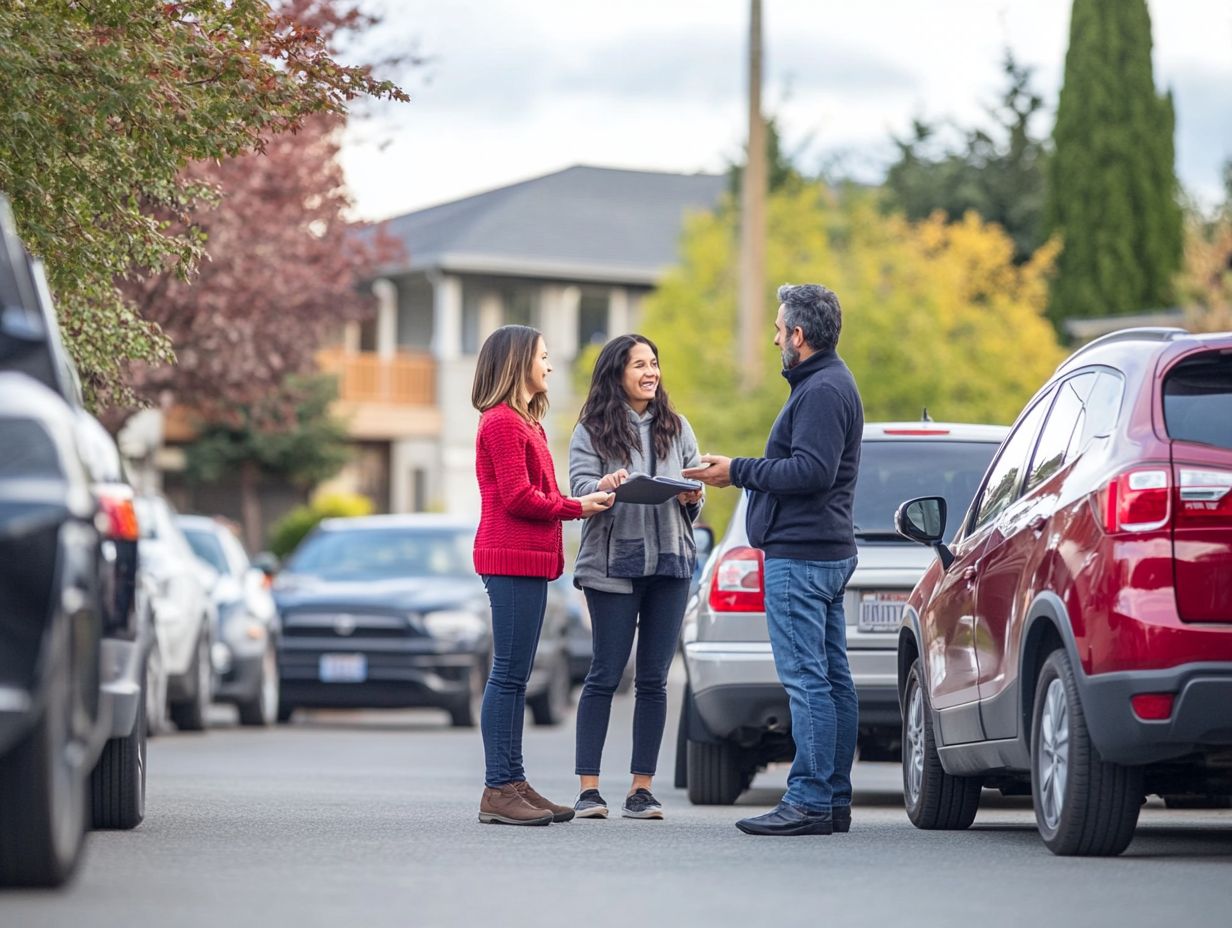What is Coverage for Personal Vehicles?
Navigating the world of auto insurance can feel daunting, particularly when it comes to understanding the coverage for your personal vehicle.
With a variety of coverage types available like liability, collision, and comprehensive it s essential to understand their meanings and importance. This article unpacks the different coverage options, explores the factors influencing insurance rates, and offers tips for selecting the policy that best suits your needs.
Moreover, it will tackle common misconceptions that could cloud your judgment. By knowing these factors, you can take action now to make informed decisions that protect your vehicle and finances.
Contents
Key Takeaways:

- Coverage for personal vehicles is essential to protect yourself and your car from financial losses in case of accidents or damages.
- There are different types of coverage available, such as liability, collision, and comprehensive, each serving a specific purpose.
- Factors such as age and type of vehicle, driving record, and location can affect the coverage and premiums for personal vehicles.
Why Personal Vehicle Coverage Matters
Understanding coverage for personal vehicles is essential for you as a vehicle owner. It ensures that you meet state-required insurance minimums while also protecting yourself from potential financial burdens that can arise from car accidents, including coverage for rental vehicles.
Auto insurance offers a range of coverage options, including liability coverage, which shields you from bodily injury claims, property damage liabilities, and personal injury protection. Understanding the differences between comprehensive and collision coverage is key to making informed decisions that fulfill your financial responsibilities.
Types of Coverage for Personal Vehicles
In terms of personal vehicles, grasping the nuances of personal property coverage in auto insurance is crucial for protecting your investment and ensuring you have adequate safeguards in place in the event of an accident.
You’ll encounter several primary types of coverage. Liability coverage addresses bodily injury and property damage. Collision coverage assists in covering vehicle repairs, while comprehensive coverage shields you against damages not related to collisions.
Options like uninsured and underinsured motorist coverage, gap insurance, and rental reimbursement or roadside assistance add valuable layers of security to your overall protection strategy.
Liability Coverage
Liability coverage is an essential aspect of auto insurance that safeguards you from the financial fallout of bodily injury and property damage resulting from accidents where you are deemed at fault. This coverage is essential for fulfilling state-required insurance minimums.
Typically, it comes in two primary forms: bodily injury liability, which takes care of medical expenses for injured individuals, and property damage liability, which covers repairs for damaged vehicles or property.
Grasping the limits of this coverage is vital; most policies impose a cap on payouts that can leave you exposed. For instance, if you find yourself responsible for an accident that incurs $200,000 in medical bills but only carry a $100,000 limit, you could face a lawsuit for the remaining $100,000.
Insufficient liability coverage can trigger severe financial repercussions, including wage garnishment and the potential loss of assets. Many states require a minimum level of liability coverage, meaning that inadequate coverage not only jeopardizes your financial stability but also complicates your compliance with local regulations.
By ensuring that you have adequate limits, you protect yourself not only from immediate expenses but also from prolonged legal troubles that could emerge from serious accidents.
In conclusion, understanding auto insurance is crucial for protecting your investment and financial security. Review your current coverage to ensure it meets your needs, and consider consulting an expert for personalized advice.
Collision Coverage
Collision coverage is an important part of your auto insurance. It provides financial protection for damages to your vehicle resulting from a collision with another vehicle or object, regardless of who s at fault. You can repair or replace your vehicle after an accident, but you ll need to pay a deductible the amount you pay out of pocket before insurance helps first.
Selecting the right amount of collision coverage is crucial. It directly impacts your repair costs and monthly payments. The deductible can vary widely. Generally, opting for a higher deductible lowers your monthly payments but may expose you to larger expenses when filing a claim.
Several factors influence the cost of collision coverage. These include your driving history, the type of vehicle you own, and where you live. For example, a recent accident might raise your premiums, while a safer, less expensive vehicle can lead to reduced costs.
Imagine this: you collide with a guardrail. Knowing about collision coverage can save you from headaches and make the difference between facing financial strain and enjoying a smooth recovery.
Comprehensive Coverage

Comprehensive coverage protects your vehicle against various non-collision-related damages, such as theft, vandalism, natural disasters, or even hitting an animal. For those with watercraft, understanding coverage for personal watercraft is equally important. Unlike collision coverage, comprehensive coverage acts as a reliable safeguard and is an invaluable part of your auto insurance policy.
This type of coverage lets you drive confidently, knowing you’re protected from unexpected events that could lead to costly repairs or even total loss. By opting for comprehensive coverage, you can significantly influence your insurance quotes, often resulting in higher monthly payments due to the enhanced protection it offers.
This investment is worthwhile because it complements other options like liability and collision, creating a robust safety net that fosters peace of mind.
Factors Affecting Coverage for Personal Vehicles
When choosing the right auto insurance policy for your vehicle, it s crucial to understand key factors that influence both coverage and cost.
The age and type of your vehicle are significant determinants. Newer or luxury models typically require higher coverage amounts because of their increased value. Your driving history, including your record and past claims, also plays a vital role in shaping the available premiums and coverage options.
Don’t overlook the impact of your location and how you use your vehicle, as these elements factor into the overall risk assessment conducted by insurance companies.
Age and Type of Vehicle
The age and type of your vehicle are pivotal factors that influence your auto insurance costs and the coverage amounts you may need. Typically, newer and more expensive models attract higher premiums. Insurers assess your vehicle s value, safety ratings, and repair costs to determine the necessary coverage, impacting both the types of coverage you might select and your overall insurance expenses.
If you own a luxury or sports car, you ll likely need specialized coverage due to its higher repair costs and increased risk of theft, leading to significantly elevated premiums compared to older, more common vehicles.
If your vehicle boasts advanced safety features, your insurance rates may dip. Cars equipped with anti-lock brakes, airbags, and collision avoidance systems are generally viewed more favorably by insurers.
A vehicle s repair history is also crucial. If your car is known for frequent issues or costly repairs, you could see higher premiums. This highlights the importance of considering your vehicle’s background when evaluating your insurance options.
Driving Record
Your driving record plays a crucial role in determining your auto insurance costs. Insurers closely examine your past driving behavior to assess the level of risk they take on by insuring you. Factors such as previous accidents and traffic violations significantly influence your premiums and reflect your financial responsibility.
A clean driving record can lower your insurance costs. Insurers tend to reward responsible drivers who demonstrate they can stay safe on the road. Conversely, a record filled with multiple violations or accidents could lead to a considerable increase in your premiums, as insurance companies perceive you as a heightened risk.
Remember, regulations and practices vary from state to state. Some states may impose stricter penalties for infractions, while others might offer incentives for safe driving. Over time, these cumulative effects can create significant disparities in insurance expenses, putting those with poor driving records at a considerable financial disadvantage.
Location and Usage
The location where you primarily use your vehicle, along with its intended purpose, plays a pivotal role in determining your insurance costs and the types of coverage you ll need. If you re in an urban area with heavy traffic and a higher likelihood of theft or accidents, you can expect to pay increased premiums. In contrast, rural areas often offer more favorable rates due to lower associated risks.
In urban environments, the chances of a collision rise significantly due to congestion and frequent stops, which drives up insurance costs. On the other hand, in rural regions, where open roads are common and police interactions are less frequent, drivers often enjoy lower premiums.
How you use your vehicle is equally important. For instance, if you primarily use your car for commuting, your coverage needs may differ from those who drive strictly for leisure or business purposes, especially when considering coverage for vintage cars.
State laws add another layer of complexity, as different regions require various levels of coverage. It s essential to examine both local regulations and your individual needs to pinpoint the best policy for your situation.
Choosing the Right Coverage for Your Vehicle

Selecting the right coverage for your vehicle requires a careful assessment of your specific needs, budget, and the available options to ensure you receive optimal protection against potential risks.
It s essential to compare different insurance providers, as each can present varying quotes and coverage plans tailored to your circumstances and financial responsibilities. Taking the time to make these comparisons will enable you to make an informed decision that best suits your situation.
Don t wait! Start comparing insurance options today to secure the best deal for you!
Evaluating Your Needs and Budget
Evaluating your needs and budget is the first step in selecting the right auto insurance coverage. Consider factors like your vehicle’s value, your driving habits, and your financial responsibilities. Understanding your coverage requirements will help you make choices that align with your budget while meeting state insurance mandates.
Start by assessing the current market value of your vehicle, as this significantly impacts the amount of coverage you may need. Next, reflect on your driving patterns how often you commute and whether you use your vehicle for business. This understanding helps you weigh the potential risks you face on the road.
Once you have defined these needs, establish a realistic budget for your insurance costs. Deliberate on different deductible options the amount you pay out of pocket before insurance kicks in and various coverage levels to strike a balance between affordability and adequate protection. This way, you can tailor your policy to suit your lifestyle and financial aspirations.
Comparing Different Insurance Providers
Comparing different insurance providers is essential. It helps you find the best auto insurance policy that fits your needs and budget.
Each provider presents unique insurance quotes and coverage options designed for various customers. By understanding the differences in coverage amounts, customer service quality, and claims processes, you can make an informed choice.
As you explore your options, consider factors like customer reviews and experiences to assess each provider’s reliability. A closer examination of how claims are handled will reveal their efficiency and responsiveness when you need support the most.
Explore features like roadside assistance and rental reimbursement, as these can provide peace of mind during urgent situations and potentially save you both money and hassle.
All these elements come together to give you a clear understanding, enabling you to select an insurance plan that not only fits your budget but also aligns seamlessly with your lifestyle and expectations.
Common Misconceptions about Coverage for Personal Vehicles
You may encounter a variety of misconceptions surrounding auto insurance and coverage for personal vehicles, which can lead you to make uninformed decisions about your insurance policies.
Common myths include the notion that minimum liability coverage (which covers costs if you cause an accident) is adequate for all drivers or that comprehensive coverage (which protects against damage not caused by a collision, like theft or natural disasters) is only essential for luxury vehicles. Relying on these beliefs can leave you with insufficient protection against potential risks.
Myth vs. Reality
Understanding the myth versus reality of auto insurance can profoundly influence your approach to coverage decisions. Many common misconceptions can lead to inadequate protection or unnecessarily high insurance costs.
For instance, the belief that all insurance policies are created equal misses the crucial nuances in coverage options and the significance of tailored policies that cater to your individual needs.
This misunderstanding might prompt you to settle for minimum coverage, which may seem like a smart financial move in the short term but can lead to dire financial consequences down the line. Missing out on the right coverage can lead to serious financial trouble.
Statistics reveal that drivers with only liability coverage frequently find themselves paying out-of-pocket for damages that surpass their policy limits, resulting in thousands of dollars in repairs and medical bills.
Some individuals mistakenly assume that all insurance companies offer uniform rates, overlooking the fact that comparison shopping can yield substantial savings and superior coverage options. Engaging with a knowledgeable agent can illuminate these misconceptions and steer you toward more informed and responsible financial decisions.
Frequently Asked Questions

What is Coverage for Personal Vehicles?
Coverage for personal vehicles refers to the insurance policies that provide financial protection in case of an accident or damage to your personal vehicle, including coverage for specialized vehicles.
What does Coverage for Personal Vehicles typically include?
Coverage for personal vehicles typically includes liability coverage, collision coverage, and comprehensive coverage. Additionally, it may involve coverage for utility vehicles and other optional coverages such as roadside assistance and rental car reimbursement.
Is Coverage for Personal Vehicles mandatory?
While most states require drivers to have minimum liability coverage, other coverages such as collision and comprehensive are optional. However, it is highly recommended to have these coverages to protect your personal vehicle and yourself financially.
How does Coverage for Personal Vehicles work?
When you have an auto insurance policy that includes coverage for special interest vehicles, you pay a premium to the insurance company. In case of an accident or damage to your vehicle, the insurance company will cover the costs up to the limit of your policy.
Can I customize my Coverage for Personal Vehicles?
Yes, you can customize your coverage for personal vehicles by adding optional coverages or adjusting the limits of your existing coverages. To learn more about how this applies to recreational vehicles, check out what is coverage for recreational vehicles? This allows you to tailor your insurance policy to fit your specific needs and budget.
What Affects the Cost of Insurance for Personal Vehicles?
The cost of insurance for personal vehicles varies based on factors like your driving history, the type of vehicle you own, and your location. A clean driving history often leads to lower costs, while certain cars may be more expensive to insure.
It s crucial to compare quotes from different insurance companies. This way, you can find the best coverage at a price that fits your budget. Don’t wait – your ideal policy may be just a click away!






